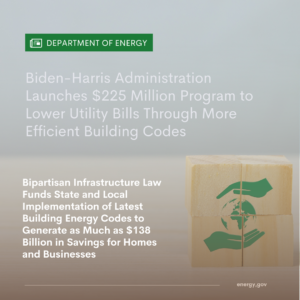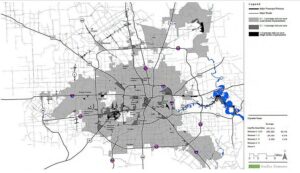Building Codes
Building codes are a set of regulations that are used as a standard for construction, both buildings and non-building structures. These codes are made and enforced to protect public health and safety. They vary widely based on location with different states and municipalities having their own specific codes, but the International Building Code (IBC) lists the commonly used as a base reference for building codes.
About a year ago, the Biden-Harris Administration launched a $225 million project called The National Building Code Initiative. This initiative is intended to incentivize state and local governments to adopt new building codes and regulations thereby cutting carbon and other greenhouse gas emissions from the construction sector. Buildings already constructed to the qualities of this initiative were not affected, but in locations that adopted these proposed new codes, many new and existing buildings and construction drawings had to be altered to adhere to these codes.
Updating and adding additional building codes affects everyone in the construction sector and everyone that interacts with or relies on the construction sector. These parameters can include anyone from general contractors and architects to minimum wage workers renting apartments that now must be updated. Alterations and additions to building codes can be very controversial as they can be beneficial for safety and the environment but a great hindrance for workers in the construction industry.
Environmental Impact and Protection Laws
 Environmental impact and protection laws as they relate to construction are rules and regulations that construction projects must comply with. They are designed to help protect the environment from construction sector related impacts as well as prevent further environmental contamination. Construction is innately impactful and disruptive to the natural environment but is largely viewed as necessary in the human dominated world. Due to this, it is vital that we make every effort to balance the need for construction and the needs of the environment. This is where environmental law comes in. These can range from waste disposal laws to important legislation such as the Clean Air Act and the Clean Water Act.
Environmental impact and protection laws as they relate to construction are rules and regulations that construction projects must comply with. They are designed to help protect the environment from construction sector related impacts as well as prevent further environmental contamination. Construction is innately impactful and disruptive to the natural environment but is largely viewed as necessary in the human dominated world. Due to this, it is vital that we make every effort to balance the need for construction and the needs of the environment. This is where environmental law comes in. These can range from waste disposal laws to important legislation such as the Clean Air Act and the Clean Water Act.
Recent legislation regarding environmental laws relating to the construction community includes the Property Assessed Clean Energy (PACE) program which impacts both commercial and residential development. This program aims to aid in the securing of finance, the development and installation of renewable energy systems. This program has been brought to over 37 states as well as the District of Columbia and provides encouragement and incentive for individuals and contractors to install energy efficient and renewable energy systems without putting funds, and therefore entire projects, at risk. However, there are downside to this program including but not limited to:
- The PACE program is only available to property owners
- Finances acquired through the program cannot be used on portable items. Examples provided by the Department of Energy include screw-in light bulbs and standard refrigerators.
- This program is not available for investments below $2,500.
- Securing PACE financing can be a long process requiring complex legal and administrative set up.
- The PACE program is not available in all parts of the United States.
Labor Laws
Every United States industry is subject to labor laws and the construction industry is no exception. Required to comply with laws such as the Fair Labor Standards Act (FLSA), the Occupational Safety and Health Act, and the Family and Medical Leave Act (FMLA), the construction sector is impacted by most all changes to federal labor laws. New labor laws and labor law changes can also be implemented on the state level.
Safety Regulations
Safety regulations are employed and enforced on every construction site. These standards are set by the Occupational Safety and Health Administration (OSHA) and are designed to ensure a safe and healthy workplace for all employees and visitors. Standards can vary based on location, but OSHA regulations are federal regulations and represent the minimum legal requirements for job site health and safety that companies must follow. OSHA and other safety regulations are constantly evolving as technology and the workplace evolves.
The National Emphasis Program (NEP) recently made new regulations aimed at protecting workers from heat hazards. Hazards such as heat-stroke and heat stress can lead to permanent injury or death and, given the right workplace environment and tools are almost entirely preventable. While these new regulations may cost companies money in the short run providing properly acclimated resting places and the materials necessary to prevent individuals (especially those working outside) for over-heating and experiencing heat related illness, may save them time, money, potential lawsuits, and lives in the long run.
After these OSHA regulations went into effect Texas Governor signed HB 2127 — the Texas Regulatory Consistency Act. This act will take effect on September 1, 2023. Among other things, it overturned local regulations that mandated rest breaks for construction workers in places like Austin and Dallas. Although workers may still be granted rest breaks, this legislation makes it, so construction workers are no longer entitled (inherently deserving) to them. This change may impact contracting companies little, but construction workers across the state of Texas could be affected. This begs the question: In an industry already short on skilled labor, is taking away worker’s rights beneficial to anyone?
Zoning Laws
 Zoning laws come at federal, state, and local levels. Like most laws that are implemented and enforced at several levels of government, zoning laws vary widely based on location. These laws regulate what type of structures can be placed and maintained in specific areas within a municipality. For example, most towns have residential and commercial areas which is why it is rare to see homes located on the same block as grocery stores or high-rises.
Zoning laws come at federal, state, and local levels. Like most laws that are implemented and enforced at several levels of government, zoning laws vary widely based on location. These laws regulate what type of structures can be placed and maintained in specific areas within a municipality. For example, most towns have residential and commercial areas which is why it is rare to see homes located on the same block as grocery stores or high-rises.
As for examples of recent zoning law changes that may affect construction, simply look up the phrase “zoning law changes in my area” as these laws are extremely specific and always changing.
Licensing Laws
Contractors are required to have a license in order to operate. The laws regarding contractor licensing are typically governed at the state level and continuously changing to fit the needs of the state or area in which they are being enforced. This includes the regulations related to and impacting the issuance of building permits and building fines.
Conclusion
Contractors and clients should stay up to date on all construction law changes on the federal, state, and local governmental levels to ensure the safety of workers along with the efficiency and success of their projects.





